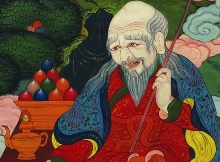The Mongolian Lord of Nature
 |
 |
 |
Tsagaan Uvgun, the White Old Man of Mongolian mythology. |
The following information has been extracted from the
Mongolian Buddhists Protecting Nature Handbook which can be downloaded in English and in Mongolian.
Tsagaan Uvgun is the White Old Man of Mongolian mythology, often depicted
surrounded by the six traditional symbols of longevity (in Tibetan, “Tsering Nam Tuk”.
These are: the divine peach tree, the conch-shaped rock, the crane, the crystal rosary,
the pure stream welling up from a sacred rock, and the deer – which are said to be
the only creatures able to locate the plants (or fungus) of immortality.
In Tibetan, he is called “Tsering Tuk”, or the Bodhisattva of Longevity. In China he is
Shou-lao. But wherever he is, whatever he is called, he is a supreme example of how
to live in harmony with nature. What use is living for a long time, if we are not living
in a beautiful place?
A painting commissioned by Gandan Monastery in 2008, and painted by the respected
Mongolian artist Mr. Dulguun, reinterpreted this image – popular throughout Central
and Northern Asia - to encourage people to remember how powerful their role can
be in protecting the land.
In this new painting, now made into a
poster
and distributed to monasteries and schools around Mongolia, Tsagaan Uvgun is still there at the centre. He is an old man with white
hair and flowing beard, living in a tranquil, beautiful landscape: the kind of place
which human beings inhabit in their happiest dreams. And close to him are the deer
and the water and cranes and the other traditional symbols of longevity. But also
around him - helping create, perpetuate and protect the perfect landscape - are
monks and laypeople.
Some of them are doing a sacred sand offering to a stream and pouring it sweetly.
Others are worshipping a sacred ovoo to protect the mountains – with the support
of lay devotees. Others are going out into the landscape to do an animal liberating
ceremony by reciting the appropriate sacred sutras for this event so that the animal
can go with no fear from humans. In another scene, monks are performing prayers
and pleading with the nagas of the trees to forgive those who cut them down. The
tree-cutters themselves are shown making confessions: they have suffered unhappiness
because the nagas have been angry.
The symbols of longevity and natural harmony are:
1. Peaches, said to be the fruits of everlasting life. They represent the abundance of
the natural world.
2. A pine tree, which being evergreen, is also a sign of long life: it represents how we
need vegetation.
3. The water of longevity, with the eight precious qualities of being clear, cool, healing,
odourless, soothing, delicious, light and soft. It represents the importance of pure,
unpolluted water both for drinking and for sustaining the earth and its creatures. It
comes from a rock that is in the shape of a conch.
4. The rock of longevity, which does not change: its fissures are often curved like the
bends of a conch shell. Mongolians and Tibetans see it as a holy mountain, which
must be prayed for and respected. This reminds us of the grandeur of nature, and
emphasizes that humans are only a part of something greater.
5. Cranes, which are believed to be the most long-lived birds.
6. Deer, which are the vehicle of Tsering Tuk – who is sometimes shown riding a stag.
Deer, like holy mendicants, are traditionally believed to sleep in a different place
each night. In this painting the deer and the cranes are reminders of how human
beings should respect the lives of animals and birds, in order to ensure a landscape
and life that is in harmony. They can’t live to be old, unless we allow them to do so
by refraining from hunting them and destroying their habitats.
“The six symbols inspire us to cherish all life on the earth,” commented His Eminence
Khamba Lama, Gabju Choijamts Demberel, the abbot of Gandan Monastery. And
Venerable Da Lama Kh. Byambajav added: “And the four scenes in the new painting
remind us that now we must actively participate in protecting nature and the land.”
Pages about Mongolian Environmental Wisdom, taken from the Handbook.
The Mongolian Lord of Nature.
Sacred texts, places and ovoos.
Sacred sites
in Mongolia.
Traditional Environmental Law in Mongolia.
The work that the monks, in conjunction with ARC and the World Bank and others, are carrying out to rediscover the sutras about sacred land in Mongolia.
Do you want to support this?
For full contact and address details of Mongolian Buddhist Monasteries, please see page 57 of the
Handbook. And for details of local Development, Environmental and Educational NGOs, please visit pages 58-59 of the
Handbook.
Other links to Mongolian Buddhism and the Environment
Link here to access the news story about the launch of the Mongolian Buddhist Handbook.
Link
here to download the Mongolian Buddhist Handbook in English. (Please note this file is 1.15MB)
Link
here to download the Mongolian version of the Handbook.(A 2MB file.)
Link here to download the guide to the Mongolian Buddhists’ Eight Year Plan (this file is 4.13MB).
Link to Mongolian Case Studies.
And
here on how to make contact with the Sangha.
To download the A3 poster of a new thangka about Buddhists protecting Nature, link
here (5.61MB).
Brief History of Mongolian Buddhism.
Buddhism and the Environment.
Women in Buddhism in Mongolia.
Key Figures in Mongolian Buddhism.
Key Meetings in Mongolia.
Mongolian Buddhists and Development.
Mongolian Buddhists and Ecology.
Mongolian Buddhist Hunting Ban.
The Lost Sutras.
|

